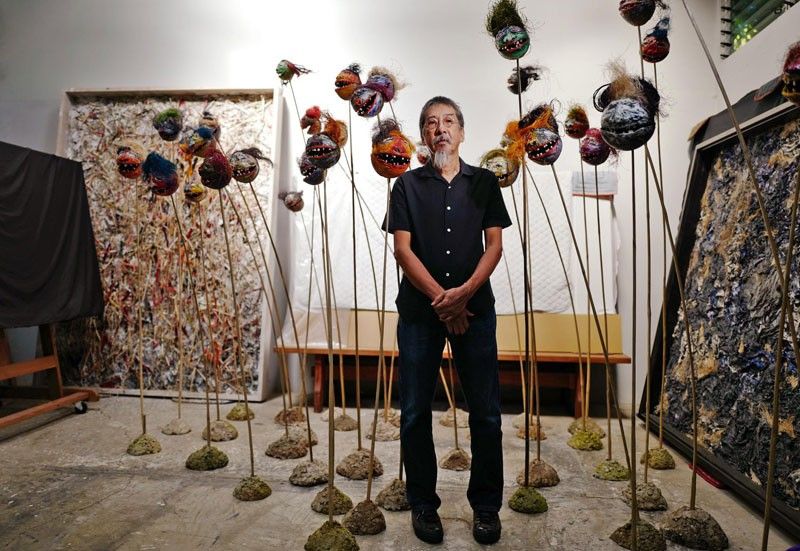Oca Villamiel isn’t playing for laughs

MANILA, Philippines — When I went to Oca Villamiel’s exhibition “Back to Nature” at Finale Art File last year, I had that great, lingering sensation of being surrounded by rain. Villamiel’s works, at their most ambitious, engulf vision, in the sense they aren’t just something we see, but something we enter. Composed of thousands of scrap nails driven to skeletal growths, rising from a field of firewood charcoal, the show’s large-scale installation is a push and pull between barrenness and wild growth. Like rain and grass, they act like rustling screens; I could almost hear them hiss and rattle as I moved.
Villamiel compels his audience to move. In thinking about this show, as I work through the pulp and get to the pith of this overgrowth, I find a message that cuts and wounds. It was a show that dealt with destruction and loss of earth, a story of shelters that collapsed, rendered through the veil of something beautiful. The allure of Villamiel’s works for me has to do with the tension between violence and beauty, the hint of deceit that gives way to revelation, the thought of these two opposing forces co-existing in the world, the object, and possibly the viewer.
In a Wednesday afternoon graced by light rain, I sit down with Villamiel as he talks about his work for Art Fair Philippines. His studio is spacious and airy and filled with knickknacks amassed from places. As our conversation moves from the Spanish regime to present-day politics, to traffic, to Japan’s old temples, chirping birds from outside provide a calming ambient sound, joined eventually by George Harrison’s voice playing from the speaker.
Coconut shells resemble eerie smiling heads hanging from the tops of bamboo poles. Loud and burning with color, Villamiel’s “Cheap Medicine” appears like the Filipino counterpart of the drama mask Thalia, except that here in the country, there is no pretense to performance. Laughter is a daily response to harrowing news. Laughing presents itself as a state of being. Here, Villamiel once again deploys his work through repetition. These few laughing faces confront the viewer like wild grass.
Villamiel’s practice begins with collection. In this show, he has grown and amassed his material from Antimonan, Quezon. “Nagkokopra kami doon,” he says. “Biyak na ‘yong shells. Marami ‘yan, thousands! Doon ko nakita; ang sabi ko, ano ba’ng puwede kong gawin dito?” The artist often likens himself to a scavenger drawn to surplus. In beginning with material, his process always follows a sense of spontaneity and slow discovery. Villamiel allows himself to be led by chance, and from there, he imagines the possibilities of presentation: mounds and cascades of horns (“Mga Damong Ligaw”), doll heads in cages within a sparsely lighted chamber (“Children of War”), feathers trapped in tiny bottles (“Back to Nature”).
The joy that Villamiel finds in producing installations that pave the way to art environments may have had its roots in his experience as a production designer. After studying fine arts at the University of the East, Villamiel worked for 10 years as a set designer for television shows such as the ’80s comedy gag Champoy. He recounts, “Kung ano ang kailangan ng show, bibigay mo ‘yan, (kahit) studio na i-coconvert sa forest. ‘Yon na pala ang interest ko, installation.” The work of building, filling up space, activating environments that invite one to move has now been carried over to his art-making.
And the task of finding resonances is ours. Villamiel merely hints at narratives but never forces them. As a whole, “Cheap Medicine” invites issues of economy, politics, and labor. Hard shells, cracked in half, recall the laborious process of extracting from coconut meat and the grind of workers involved in its production. In the schemes of things, these lives are bound to systems defined by market flux and precarious power relations. Hands from the tips of the economic pyramid control the market, to which the government chooses to pay no heed. Conceived and begun in 2010, the work was initially meant as a reaction to the elections that have consistently been putting the wrong heads into power. This web of things informs the making of the work; yet the work itself chooses not to provoke, but to evoke. Laughter is a response, a routine of simultaneously masking and revealing pain deeply lodged in the gut. We are reminded that these masks, these lives, are as much the artist’s as they are ours.
Reading into Villamiel’s works is like peeling away the flesh of a fruit to get to its pith. Often, what I find beneath hard material and wild growth is grief. The grand sprawling landscape betrays a forest burning. The repetition, largeness and mass are visual counterpoints to absence. Behind laughter is something sore and deeply hollow. Oca Villamiel may be angry, but his howls are veiled in birdsong. Instead of pointed messages, what we get are painted faces, hair of abaca fiber, and crooked teeth. These heads are familiar, but what exactly do they want? Perhaps like clowns bearing down on children, they’re telling us to laugh.



















